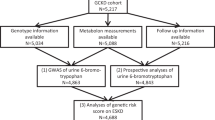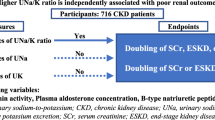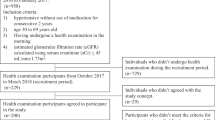Abstract
Background and objective: Alterations in renal kallikrein excretion are well-described in hypertension, and kallikrein excretion may predict risk of developing hypertension, but kallikrein excretion has not been directly compared across several ethnic strata, nor have the effects of ethnicity, gender, environment, and genetic risk of hypertension been simultaneously considered as determinants of kallikrein.
Methods: We investigated determinants of kallikrein excretion in a cross-section of n = 204 normotensive subjects stratified by ethnicity (119 Caucasian, 33 African-American, 52 Asian), gender (109 men, 95 women), environment (spontaneous electrolyte intake/excretion), and heredity (genetic risk (family history) of hypertension). Results were interpreted by analysis of variance (with Bonferroni post hoc comparison corrections), analysis of covariance, multiple linear regression, and maximum likelihood.
Results: Urinary kallikrein activity varied substantially (F = 5.30, P = 0.006) across the three ethnic groups, with African-American values ∼50% lower than Caucasian (P = 0.005) or Asian (P = 0.02). Ethnicity and gender (T = 3.24, P = 0.001) had independent effects on kallikrein, with women excreting ∼50% more kallikrein than men, regardless of ethnicity. Subjects at genetic risk of hypertension were over-represented (P = 0.048) in the lower stratum of a bimodal distribution of kallikrein excretion (chi-square = 29.6, P < 0.001). potassium excretion was diminished in african-americans (P < 0.001 to P = 0.002), and in a multivariate analysis, potassium excretion was the strongest correlate of kallikrein excretion (T = 4.10, P = 0.0001). In a subset of Caucasian and African-American individuals, African-Americans exhibited diminished excretion of not only kallikrein and potassium, but also aldosterone (P = 0.003), suggesting a mechanistic link between potassium and kallikrein excretion in their ethnic variations.
Conclusions:Kallikrein excretion is influenced by several independent determinants, both hereditary (gender, ethnicity, and genetic risk of hypertension) and environmental (potassium intake and excretion). Ethnicity and environment may interact uniquely to influence kallikrein, as demonstrated by the case of African-Americans with diminutions of both kallikrein and potassium excretion. These results suggest a mechanism whereby kallikrein excretion is diminished in African-Americans, as well as therapeutic strategies to correct this deficiency. Finally, the identified determinants of kallikrein excretion will require analytic adjustment during genetic studies of this ‘intermediate phenotype’ in hypertension.
This is a preview of subscription content, access via your institution
Access options
Subscribe to this journal
Receive 12 digital issues and online access to articles
$119.00 per year
only $9.92 per issue
Buy this article
- Purchase on Springer Link
- Instant access to full article PDF
Prices may be subject to local taxes which are calculated during checkout
Similar content being viewed by others
Author information
Authors and Affiliations
Corresponding author
Rights and permissions
About this article
Cite this article
Song, C., Martinez, J., Kailasam, M. et al. Renal kallikrein excretion: role of ethnicity, gender, environment, and genetic risk of hypertension. J Hum Hypertens 14, 461–468 (2000). https://doi.org/10.1038/sj.jhh.1001047
Received:
Accepted:
Published:
Issue Date:
DOI: https://doi.org/10.1038/sj.jhh.1001047
Keywords
This article is cited by
-
Partial genetic deficiency in tissue kallikrein impairs adaptation to high potassium intake in humans
Kidney International (2013)
-
Renal kallikrein excretion and epigenetics in human acute kidney injury: Expression, mechanisms and consequences
BMC Nephrology (2011)
-
Neural Correlates of Visuospatial Working Memory in Healthy Young Adults at Risk for Hypertension
Brain Imaging and Behavior (2008)
-
Contributions of the sympathetic nervous system, glutathione, body mass and gender to blood pressure increase with normal aging: influence of heredity
Journal of Human Hypertension (2005)
-
Cardiovascular haemodynamic response to repeated mental stress in normotensive subjects at genetic risk of hypertension: evidence of enhanced reactivity, blunted adaptation, and delayed recovery
Journal of Human Hypertension (2003)



